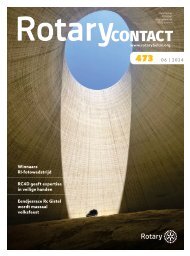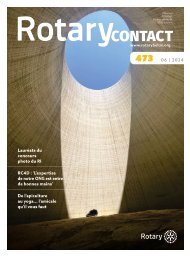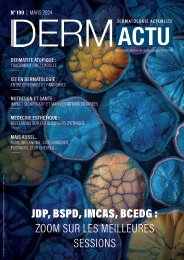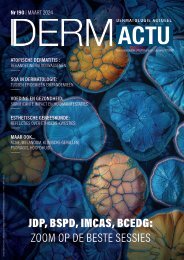Create successful ePaper yourself
Turn your PDF publications into a flip-book with our unique Google optimized e-Paper software.
Otezla ® 10 mg, 20 mg and 30 mg film-coated tablets 1. NAME OF THE MEDICINAL PRODUCT: Otezla<br />
10 mg film-coated tablets. Otezla 20 mg film-coated tablets. Otezla 30 mg film-coated tablets. 2. QUA-<br />
LITATIVE AND QUANTITATIVE COMPOSITION: Otezla 10 mg film-coated tablets: Each film- coated<br />
tablet contains 10 mg of apremilast. Excipient(s) with known effect: Each film-coated tablet contains 57<br />
mg of lactose (as lactose monohydrate). Otezla 20 mg film-coated tablets: Each film-coated tablet<br />
contains 20 mg of apremilast. Excipient(s) with known effect: Each film-coated tablet contains 114 mg<br />
of lactose (as lactose monohydrate). Otezla 30 mg film-coated tablets: Each film-coated tablet contains<br />
30 mg of apremilast. Excipient(s) with known effect: Each film-coated tablet contains 171 mg of lactose<br />
(as lactose monohydrate). For the full list of excipients, see section 6.1. 3. PHARMACEUTICAL FORM:<br />
Film-coated tablet (tablet). Otezla 10 mg film-coated tablets: Pink, diamond shaped 10 mg film-coated<br />
tablet of 8 mm length with “APR” engraved on one side and “10” on the opposite side. Otezla 20 mg<br />
film-coated tablets: Brown, diamond shaped 20 mg film-coated tablet of 10 mm length with “APR”<br />
engraved on one side and “20” on the opposite side. Otezla 30 mg film-coated tablets: Beige, diamond<br />
shaped 30 mg film-coated tablet of 12 mm length with “APR” engraved on one side and “30” on the<br />
opposite side. 4. CLINICAL PARTICULARS: 4.1 Therapeutic indications: Psoriatic arthritis: Otezla, alone<br />
or in combination with Disease Modifying Antirheumatic Drugs (DMARDs), is indicated for the<br />
treatment of active psoriatic arthritis (PsA) in adult patients who have had an inadequate response or<br />
who have been intolerant to a prior DMARD therapy (see section 5.1). Psoriasis: Otezla is indicated for<br />
the treatment of moderate to severe chronic plaque psoriasis in adult patients who failed to respond<br />
to or who have a contraindication to, or are intolerant to other systemic therapy including cyclosporine,<br />
methotrexate or psoralen and<br />
ultraviolet-A light (PUVA). Behçet’s<br />
disease: Otezla is indicated<br />
for the treatment of<br />
adult patients with oral ulcers<br />
associated with Behçet’s<br />
disease (BD) who are candidates<br />
for systemic therapy.<br />
4.2 Posology and method of<br />
administration: Treatment<br />
with Otezla should be initiated<br />
by specialists experienced<br />
in the diagnosis and treatment<br />
of psoriasis, psoriatic<br />
arthritis or Behçet’s disease.<br />
Posology: The recommended<br />
dose of apremilast is 30 mg<br />
taken orally twice daily, approximately<br />
12 hours apart<br />
(morning and evening), with<br />
no food restrictions. An initial<br />
titration schedule is required<br />
as shown below in Table 1.<br />
No re-titration is required after<br />
initial titration. Table 1.<br />
Dose titration schedule:<br />
Day 1: AM: 10 mg; Day 2: AM:<br />
10 mg. PM: 10 mg; Day 3: AM:<br />
10 mg. PM: 20 mg; Day 4: AM:<br />
20 mg. PM: 20 mg; Day 5: AM:<br />
20 mg. PM: 30 mg; Day 6 &<br />
thereafter: AM: 30 mg. PM:<br />
30 mg. If patients miss a<br />
dose, the next dose should<br />
be taken as soon as possible.<br />
If it is close to the time for<br />
their next dose, the missed<br />
dose should not be taken and<br />
the next dose should be taken<br />
at the regular time. During<br />
pivotal trials the greatest<br />
improvement was<br />
observed within the first 24<br />
weeks of treatment for PsA<br />
and PSOR and within the first<br />
12 weeks of treatment for<br />
BD. If a patient shows no evidence<br />
of therapeutic benefit<br />
after this time period, treatment<br />
should be reconsidered.<br />
The patient’s response<br />
to treatment should be evaluated<br />
on a regular basis.<br />
Special populations: Elderly<br />
patients: No dose adjustment<br />
is required for this patient<br />
population (see sections 4.8<br />
and 5.2). Patients with renal<br />
impairment: No dose adjustment<br />
is needed in patients<br />
with mild and moderate renal<br />
impairment. The dose of<br />
apremilast should be reduced<br />
to 30 mg once daily in<br />
patients with severe renal<br />
impairment (creatinine clearance<br />
of less than 30 mL per<br />
minute estimated by the<br />
Cockcroft-Gault equation).<br />
For initial dose titration in this<br />
group, it is recommended that<br />
apremilast be titrated using o<strong>nl</strong>y the AM schedule listed in Table 1 and the PM doses be skipped (see<br />
section 5.2). Patients with hepatic impairment: No dose adjustment is necessary for patients with hepatic<br />
impairment (see section 5.2). Paediatric population: The safety and efficacy of apremilast in children<br />
aged 0 to 17 years have not been established. No data are available. Method of administration: Otezla<br />
is for oral use. The film-coated tablets should be swallowed whole, and can be taken either with or<br />
without food. 4.3 Contraindications: Hypersensitivity to the active substance(s) or to any of the excipients<br />
listed in section 6.1. Pregnancy (see section 4.6). 4.8 Undesirable effects: Summary of the safety<br />
profile: The most commo<strong>nl</strong>y reported adverse reactions with apremilast in PsA and PSOR are<br />
gastrointestinal (GI) disorders including diarrhoea (15.7%) and nausea (13.9%). The other most commo<strong>nl</strong>y<br />
reported adverse reactions include upper respiratory tract infections (8.4%), headache (7.9%),<br />
and tension headache (7.2%) and are mostly mild to moderate in severity. The most commo<strong>nl</strong>y reported<br />
adverse drug reactions with apremilast in BD are diarrhoea (41.3%), nausea (19.2%), headache<br />
(14.4%), upper respiratory tract infection (11.5%), upper abdominal pain (8.7%), vomiting (8.7%) and<br />
back pain (7.7%) and are mostly mild to moderate in severity. The gastrointestinal adverse reactions<br />
generally occurred within the first 2 weeks of treatment and usually resolved within 4 weeks. Hypersensitivity<br />
reactions are uncommo<strong>nl</strong>y observed (see section 4.3). Tabulated list of adverse reactions:<br />
The adverse reactions observed in patients treated with apremilast are listed below by system organ<br />
class (SOC) and frequency for all adverse reactions. Within each SOC and frequency grouping, adverse<br />
BEL-407-0823-80002- V2.0 – creation date 5th of February 2024<br />
reactions are presented in order of<br />
decreasing seriousness. The adverse<br />
drug reactions were determined<br />
based on data from the apremilast<br />
clinical development programme<br />
and post-marketing experience.<br />
The frequencies of adverse drug<br />
APREMILAST IN PATIENTS WITH PSO or PsA<br />
with or without CARDIOMETABOLIC COMORBIDITIES 1-6<br />
Otezla ® , the first and o<strong>nl</strong>y oral PDE4-inhibitor on the market for patients with PSO<br />
or PsA, is well tolerated and requires no dose adjustment (except in severe renal<br />
impairment), monitoring or analytical screening. 1-3,a<br />
CHOOSE EFFICACY & SIMPLICITY 1-6<br />
IT IS THAT SIMPLE<br />
>8<br />
years of<br />
EXPERIENCE 9<br />
in the treatment of<br />
Experts consider apremilast a<br />
suitable option in the treatment<br />
of the psoriatic patient *# and<br />
presence of comorbidities 1,7,8<br />
Public price (VAT incl.) 2<br />
OTEZLA ® 10, 20, 30 mg 27 tabl.: 337,47 €<br />
OTEZLA ® 30 mg 56 tabl.: 688,83€<br />
reactions are those reported in the apremilast arms of the four Phase III studies in PsA (n = 1,945) or the<br />
two Phase III studies in PSOR (n = 1184), and in the phase III study in BD (n = 207) (the highest frequency<br />
from either data pool is represented in table 2). Frequencies are defined as: very common (≥ 1/10);<br />
common (≥ 1/100 to














